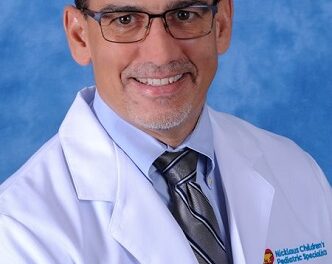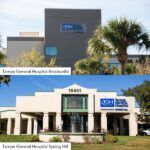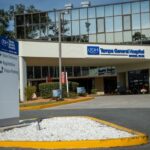To say South Florida has experienced active hurricane seasons the past couple of years would be a severe understatement. But if there is one good thing to take away from the turbulent skies that have plagued the area the last two summers, its that the communities are now able prepare for any number of scenarios involving hurricanes.
While most people are worried about having enough batteries for their flashlights, hospitals have the added concerns of keeping people safe and dealing with a variety of medical conditions under stressful circumstances. This year, Monroe, Miami-Dade, Broward, Palm Beach and Martin Counties are taking no chances preparations have begun early. Located in the Southernmost city in the continental United States, Lower Keys Medical Center in Key West, FL, a 167-bed acute healthcare facility, has hurricane preparations down to a science. After evacuating the entire hospital three times in 2005 alone, the staff is now able to prepare for and execute a total evacuation in just hours. “Our staff not only has had an opportunity to exercise the evacuation several times in the past few years, but we have also been able to drill,” said Meylan Lowe-Watler, Assistant Administrator at LKMC. “Our staff are experts and can basically have our patients packaged and ready for evacuation in a matter of four to six hours.”
As a matter of fact, the hospitals frequent hospital drills are observed and studied by state officials in order to improve other hurricane preparedness plans throughout the Florida.
Still, staff at LKMC does not stay complacent with their ability for crisis preparedness. The hospitals hurricane plan is continuously revised as lessons are learned and technology evolves.
Administrators at Mount Sinai Medical Center in Miami Beach, FL, are also preparing for hurricane season. Since Mount Sinai is known for cutting-edge technology, many patients are too critical to be safely moved from the hospital. With 955 beds, total evacuation of the facility is not an option.
“Our staff not only has had an opportunity to exercise the evacuation several times in the past few years, but we have also been able to drill,” said Meylan Lowe-Watler, Assistant Administrator at LKMC. “Our staff are experts and can basically have our patients packaged and ready for evacuation in a matter of four to six hours.”
As a matter of fact, the hospitals frequent hospital drills are observed and studied by state officials in order to improve other hurricane preparedness plans throughout the Florida.
Still, staff at LKMC does not stay complacent with their ability for crisis preparedness. The hospitals hurricane plan is continuously revised as lessons are learned and technology evolves.
Administrators at Mount Sinai Medical Center in Miami Beach, FL, are also preparing for hurricane season. Since Mount Sinai is known for cutting-edge technology, many patients are too critical to be safely moved from the hospital. With 955 beds, total evacuation of the facility is not an option.
 “Our commitment is to secure our facility as much as possible,” said Steven D. Sonenreich, president & CEO of Mount Sinai Medical Center “Thats why were deploying more capital to hurricane harden the institution.”
In order to provide the highest level of safety possible, the hospital has reinforced the building by replacing all windows in the patient tower and investing in upgrades to the medical centers structure to provide further protection from storms.
Memorial Hospital West in Pembroke Pines, FL, also has re-vamped its hurricane plans. After the past couple of seasons, the hospital is undergoing renovations that will fortify the building to above-code standards.
One thing that hospital staff and administrators have learned through the years is to pinpoint exactly what is needed during a hurricane. For example, administrators make sure a plastic surgeon is scheduled during storms due to the large number of patients needing treatment for serious lacerations and similar injuries obtained while preparing for a storm or while cleaning up afterward.
Also, staff members have noticed many parents at the hospitals pediatric emergency room after the storm are not there for actual emergencies. Instead, these parents want just want their child to be checked.
“Nothing is stable after a storm,” said Dr. Miguel Venereo, Director of Medical Affairs at Memorial Pembroke. “Many times, the parents want to make sure they can control something and that everyone is okay.”
For this reason, the staff is organizing pediatricians to be at the hospital exclusively for check-ups so that more serious cases in the emergency room can be attended to as quickly as possible.
At Delray Medical Center in Delray Beach, Fla., preparations for hurricane season are also underway. The hospital recently acquired a third generator as part of their contingency planning and is addressing the challenge of an additional fuel source. The hospitals administration has worked hard to make sure the hospital has sufficient medications, fuel, food and other essentials needed to provide for the 800 or so people who are expected to stay at the hospital during a storm.
“Our commitment is to secure our facility as much as possible,” said Steven D. Sonenreich, president & CEO of Mount Sinai Medical Center “Thats why were deploying more capital to hurricane harden the institution.”
In order to provide the highest level of safety possible, the hospital has reinforced the building by replacing all windows in the patient tower and investing in upgrades to the medical centers structure to provide further protection from storms.
Memorial Hospital West in Pembroke Pines, FL, also has re-vamped its hurricane plans. After the past couple of seasons, the hospital is undergoing renovations that will fortify the building to above-code standards.
One thing that hospital staff and administrators have learned through the years is to pinpoint exactly what is needed during a hurricane. For example, administrators make sure a plastic surgeon is scheduled during storms due to the large number of patients needing treatment for serious lacerations and similar injuries obtained while preparing for a storm or while cleaning up afterward.
Also, staff members have noticed many parents at the hospitals pediatric emergency room after the storm are not there for actual emergencies. Instead, these parents want just want their child to be checked.
“Nothing is stable after a storm,” said Dr. Miguel Venereo, Director of Medical Affairs at Memorial Pembroke. “Many times, the parents want to make sure they can control something and that everyone is okay.”
For this reason, the staff is organizing pediatricians to be at the hospital exclusively for check-ups so that more serious cases in the emergency room can be attended to as quickly as possible.
At Delray Medical Center in Delray Beach, Fla., preparations for hurricane season are also underway. The hospital recently acquired a third generator as part of their contingency planning and is addressing the challenge of an additional fuel source. The hospitals administration has worked hard to make sure the hospital has sufficient medications, fuel, food and other essentials needed to provide for the 800 or so people who are expected to stay at the hospital during a storm.
 “The bottom line is that we have to be able to take care of our patients, whether they are traumas or an illness or a minor injury,” said hospital spokeswoman Pat McCarthy. “Its not something that takes us by surprise. We plan for it, and every year we get better at it.”
Additional care has been given to making sure employees are able to work as efficiently as possible, from forming a day care center for their children, to establishing a toll-free number that is routed through Dallas, Texas, so that communication efforts do not break down.
Martin Memorial Health Systems in Stuart, FL, has focused preparations on rebuilding and fortifying structures. Its flagship hospital, the 236-bed Martin Memorial Medical Center, was damaged by hurricanes Frances, Jeanne and Wilma, but has been repaired and fortified by reinforcing the roof and adding windows that can sustain high winds.
In addition, Martin Memorial created a timeline of what preparations need to be made and at what stage of the storm event those preparations should take place. Each department has developed individual timelines to prepare for the impending storm, under the guidelines of the overall preparation strategy.
“The bottom line is that we have to be able to take care of our patients, whether they are traumas or an illness or a minor injury,” said hospital spokeswoman Pat McCarthy. “Its not something that takes us by surprise. We plan for it, and every year we get better at it.”
Additional care has been given to making sure employees are able to work as efficiently as possible, from forming a day care center for their children, to establishing a toll-free number that is routed through Dallas, Texas, so that communication efforts do not break down.
Martin Memorial Health Systems in Stuart, FL, has focused preparations on rebuilding and fortifying structures. Its flagship hospital, the 236-bed Martin Memorial Medical Center, was damaged by hurricanes Frances, Jeanne and Wilma, but has been repaired and fortified by reinforcing the roof and adding windows that can sustain high winds.
In addition, Martin Memorial created a timeline of what preparations need to be made and at what stage of the storm event those preparations should take place. Each department has developed individual timelines to prepare for the impending storm, under the guidelines of the overall preparation strategy.
 “Weve pretty much revamped the whole plan,” said Sam Steinhauer, Director of Safety, Security and Emergency Preparedness at Martin Memorial. “Everyone knows in each department what they need to do each step of the way.”
Even though the region has been battered by storm after storm, health professionals have only gotten stronger and smarter with each season. Whatever the 2006 hurricane season may bring, one thing is for sure the South Florida medical community is ready.
“Weve pretty much revamped the whole plan,” said Sam Steinhauer, Director of Safety, Security and Emergency Preparedness at Martin Memorial. “Everyone knows in each department what they need to do each step of the way.”
Even though the region has been battered by storm after storm, health professionals have only gotten stronger and smarter with each season. Whatever the 2006 hurricane season may bring, one thing is for sure the South Florida medical community is ready.


























